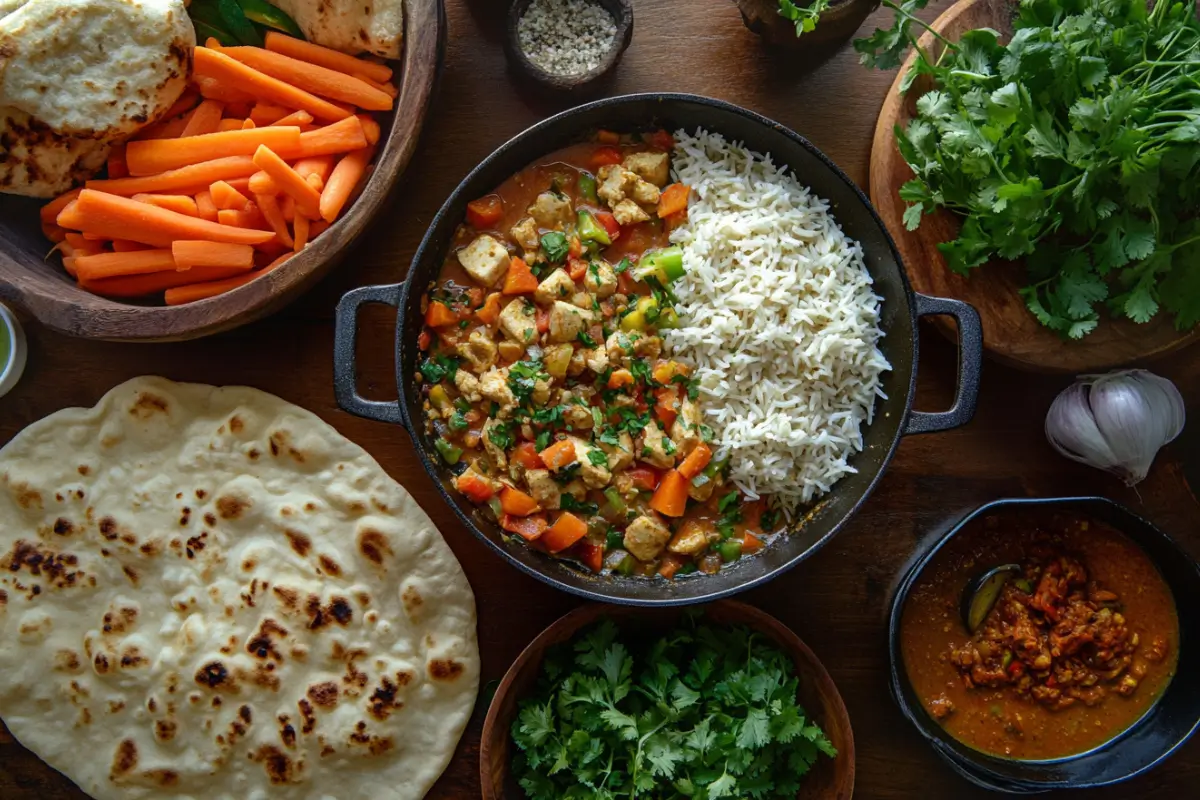Recipe JalbiteWorldFood: A Fusion of Global Flavors
Introduction to Recipe Jalbiteworldfood
1.1 Understanding Recipe Jalbiteworldfood
Recipe Jalbiteworldfood is more than just a dish—it’s an experience. Rooted in the idea of global fusion, it combines elements of various cuisines to create something entirely unique. This recipe brings together the richness of diverse culinary traditions, showcasing the versatility of ingredients and the creativity of modern cooking.
1.2 Historical Background
While the exact origins of recipe Jalbiteworldfood are unclear, its concept resonates with the globalization of food. As cultures interact, flavors and techniques from different regions meld, giving rise to innovative dishes. This recipe epitomizes the harmonious blending of Eastern spices, Western cooking methods, and local ingredients.
1.3 Nutritional Overview
One of the many appeals of recipe Jalbiteworldfood is its nutritional balance. Packed with high-quality proteins, vibrant vegetables, and whole grains, it offers a healthy meal option. It’s also adaptable to various dietary needs, making it a go-to choice for families and foodies alike.
Start a culinary journey and dive into recipe jalbiteworldfood World Food Today! cuisine. You’ll find a mix of classic dishes and new twists, and these recipes will take your taste buds on exciting adventures.
Whether you’re a pro in the kitchen or just starting out, you’ll get clear instructions and tips. You’ll also learn about the cultural roots of these dishes. Explore the world of recipe jalbiteworldfood cuisine and discover new flavors and techniques to improve your meals.
Essential Ingredients and Equipment
2.1 Core Ingredients
Creating the perfect recipe Jalbiteworldfood starts with selecting the right ingredients. Here’s a breakdown of the essentials:
- Primary Proteins: Choose from chicken, beef, seafood, or plant-based alternatives like tofu or tempeh. These serve as the foundation of the dish.
- Vegetables: Include a colorful medley such as carrots, peas, bell peppers, or zucchini. Fresh produce enhances both the taste and nutritional value.
- Grains: Use staples like basmati rice, quinoa, or bulgur wheat. They act as the perfect canvas for the rich flavors of the recipe.
- Spices and Herbs: Ground cumin, coriander, garam masala, ginger, and garlic are must-haves. These spices add warmth and depth, making the dish truly memorable.
2.2 Selecting Quality Ingredients
The quality of ingredients can make or break this dish. Opt for:
- Fresh Proteins: Look for high-quality, fresh meat or seafood. If using plant-based proteins, ensure they are firm and well-textured.
- Organic Vegetables: Choose vibrant, seasonal vegetables for optimal flavor.
- Spices and Herbs: Always use fresh or recently ground spices to achieve the boldest flavors.
2.3 Necessary Kitchen Equipment
Having the right tools on hand ensures a smooth cooking process:
Optional Appliances: A rice cooker or pressure cooker can simplify cooking grains or proteins.
Pots and Pans: Use a deep, non-stick skillet or saucepan for sautéing and simmering.
Cutting Tools: Sharp knives and a sturdy cutting board are essential for prepping ingredients efficiently.
Step-by-Step Preparation Guide
3.1 Preparation Steps
Mastering the recipe Jalbiteworldfood begins with a bit of prep work to ensure smooth cooking later.
- Washing and Soaking Grains
Rinse grains like basmati rice or quinoa under cold water until the water runs clear. This removes excess starch, preventing clumping during cooking. If the recipe calls for soaking, let the grains sit in water for 20–30 minutes to achieve an even texture. - Chopping and Marinating Proteins and Vegetables
Dice proteins like chicken or beef into bite-sized pieces. For plant-based options, cut tofu or tempeh into cubes. Marinate them with a mixture of spices, such as cumin, coriander, and garlic, for at least 15 minutes to infuse flavor. Simultaneously, chop vegetables into uniform sizes to ensure even cooking.
3.2 Cooking Process
With all the prep done, it’s time to bring the dish to life.
- Sautéing Aromatics and Spices
Heat a skillet or deep pan over medium heat and add a splash of oil. Sauté minced garlic, ginger, and onions until fragrant, about 2–3 minutes. Sprinkle in ground cumin, coriander, and garam masala, stirring frequently to release their oils and intensify their flavors. - Adding and Cooking Proteins
Add the marinated protein to the pan. Cook until it’s browned on the outside but not fully done, ensuring the spices coat every piece. - Incorporating Vegetables and Grains
Toss in the prepared vegetables, stirring gently to mix them with the aromatics and proteins. Afterward, add the soaked grains, ensuring they are evenly distributed. - Simmering to Meld Flavors
Pour in just enough water or broth to cover the mixture, and bring it to a boil. Reduce the heat, cover, and let it simmer for 20–25 minutes, allowing the flavors to meld together. Stir occasionally to prevent sticking.
3.3 Final Touches
After the cooking process, it’s the finishing details that make this dish shine.
- Garnishing with Fresh Herbs
Sprinkle freshly chopped cilantro, parsley, or dill on top for a vibrant pop of color and flavor. - Adjusting Seasoning to Taste
Taste the dish before serving, adding salt, pepper, or a squeeze of lemon juice to enhance the flavors.
Variations and Serving Suggestions
4.1 Regional Variations
The versatility of recipe Jalbiteworldfood allows for endless regional adaptations, reflecting the unique flavors of various cultures.
- Adaptations from Different Cultures
In Indian-inspired variations, you might include turmeric and chili powder for a robust, spicy kick. Middle Eastern influences could incorporate cinnamon, allspice, and a handful of dried fruits like raisins or apricots. Meanwhile, an East Asian take might swap the grains for jasmine rice and use soy sauce and sesame oil for seasoning. - Incorporating Local Ingredients
Depending on your region, you can substitute key ingredients with locally available options. For instance, use quinoa or bulgur wheat instead of rice for a South American flair, or replace standard vegetables with locally grown seasonal produce. This not only supports sustainability but also adds a fresh twist to the dish.
4.2 Dietary Modifications
Recipe Jalbiteworldfood can be tailored to fit various dietary needs without compromising flavor.
- Vegetarian and Vegan Alternatives
Replace animal proteins with chickpeas, lentils, or jackfruit for a plant-based version. Coconut milk can also substitute heavy cream for richness in vegan recipes. - Gluten-Free and Low-Carb Options
Opt for gluten-free grains like millet or cauliflower rice for a low-carb alternative. Double-check seasoning blends to ensure they are gluten-free if needed.
4.3 Serving Ideas
How you serve recipe Jalbiteworldfood can elevate its presentation and enhance its flavors.
- Pairing with Side Dishes
Serve alongside warm naan bread, a crisp cucumber salad, or roasted vegetables for a well-rounded meal. - Beverage Pairings
Pair the dish with fragrant teas like jasmine or chai for a comforting touch. For a refreshing option, mocktails with citrus or mint work wonderfully.
Conclusion: A World of Flavor in Every Bite
Recipe Jalbiteworldfood is more than just a meal—it’s a celebration of global culinary traditions brought together in one dish. By combining the best ingredients, techniques, and flavors from various cultures, it creates a unique and versatile experience for your taste buds. Whether you’re a seasoned cook or an adventurous foodie, this recipe offers endless possibilities for customization, making it suitable for any palate or occasion.
From carefully selecting quality ingredients to exploring regional variations, you now have the tools and knowledge to craft a dish that’s not only delicious but also deeply satisfying. With its adaptability to different dietary needs and meal prep convenience, recipe Jalbiteworldfood is destined to become a staple in your kitchen. So, why not give it a try? Let your creativity shine, and enjoy the journey of flavors this dish has to offer!
Frequently Asked Questions (FAQs) About Recipe Jalbiteworldfood
5.1 What is Recipe Jalbiteworldfood?
Recipe Jalbiteworldfood is a global fusion dish that combines elements from various cuisines to create a flavorful, balanced meal. Typically made with a base of grains, proteins, and vegetables, it’s enhanced by a blend of aromatic spices and herbs. This versatile recipe celebrates culinary diversity while offering plenty of room for customization to suit individual tastes.
5.2 How Do I Store Leftovers?
To store leftovers, transfer them to an airtight container once cooled. Refrigerate for up to 3 days. When reheating, add a splash of broth or water to maintain the dish’s moisture. Use a microwave or stovetop for even warming. Ensure the dish is thoroughly heated before serving, especially if it contains meat or seafood.
5.3 Can I Make It Ahead of Time?
Absolutely! Prepare the dish up to the simmering stage, then refrigerate the mixture in a covered container. When ready to serve, reheat it on the stovetop, adding a small amount of water or broth if necessary. Garnish with fresh herbs just before serving to refresh the flavors.
5.4 What Are Some Protein Alternatives?
If you prefer alternatives to chicken, beef, or seafood, try tofu, tempeh, or chickpeas for plant-based options. For a richer texture, use paneer or halloumi. These substitutes absorb the dish’s seasonings beautifully, providing equally satisfying results.
5.5 How Can I Adjust the Spice Level?
To reduce spice, use milder seasoning blends and add dairy-based ingredients like yogurt to balance heat. For a spicier kick, include additional chili powder or freshly chopped green chilies. Taste as you go to ensure the spice level suits your preference.
5.6 Is It Suitable for Meal Prep?
Yes! Recipe Jalbiteworldfood is ideal for meal prep due to its versatility and ease of reheating. Divide the cooked dish into portion-sized containers and store them in the refrigerator. Add fresh garnishes like herbs or citrus before serving to keep it vibrant.
5.7 What Sides Complement This Dish?
Pair the dish with a variety of accompaniments for a complete meal. Popular options include naan bread, garlic-infused flatbreads, steamed vegetables, or a light cucumber yogurt salad. These sides balance the dish’s rich and spiced flavors.
5.8 Can I Freeze Recipe Jalbiteworldfood?
Yes, it’s freezer-friendly. Let the dish cool completely before transferring it to freezer-safe containers. Label and store for up to 3 months. When ready to use, thaw overnight in the fridge and reheat gently on the stovetop, adding a bit of water or broth to maintain its texture.
5.9 How Do I Reheat Without Drying It Out?
To reheat without losing moisture, add a small splash of water or broth to the dish. Cover it while reheating in the microwave or on the stovetop. Stir occasionally to ensure even heating and prevent drying out.
5.10 Are There Regional Names for This Dish?
Though recipe Jalbiteworldfood is a modern creation, it’s influenced by dishes from multiple cuisines. It shares similarities with Indian pulao, Middle Eastern pilaf, and Mediterranean grain bowls. Regional names and adaptations reflect the ingredients and techniques popular in those areas.

